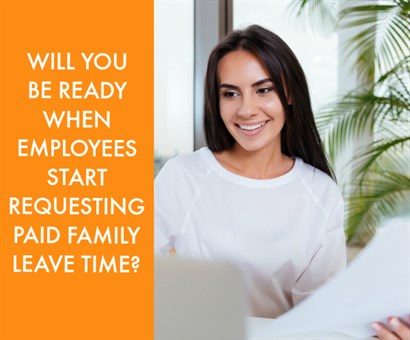
Job-protected paid leave to bond with a new child, care for a relative with a serious health condition, or having a loved one called to active duty in the military
**See updated figures for 2026** In 2016, New York State passed a Paid Family Leave (PFL) law that provides partial income replacement and job protection while workers are on leave for covered reasons. There are many factors at play with this law and the regulations associated with it which will impact almost every employer in the state. That's why our team of human resource and payroll professionals have put together this material, to help organizations navigate and explain this complex environment.
Here's what you need to know:
Paid Family Leave is intended to provide workers in New York with job-protected paid leave to bond with a new child, care for a relative with a serious health condition, or to relieve the pressure of having a loved one called to active duty in the military. Just as employers are required to provide Workers' Compensation insurance and NYS Disability insurance, they are required to provide Paid Family Leave coverage, though they may deduct the premium contributions from their employees.
Employers are required to purchase a PFL insurance policy from their NYS Disability carrier or they can self-insure1. The income replacement will be fully funded by mandatory employee payroll deductions.
Eligible employees may collect up to 12 weeks of paid leave at up to 67% of their average weekly wage or 67% the statewide average weekly wage (SAWW), whichever is smaller.
|
Effective Date |
Max. Length of Paid Leave |
Payable % of the Employee’s Average Weekly Salary |
Max. % of |
Maximum Weekly Benefit |
|
1/1/2025 |
12 weeks |
67% |
67% of $1,757.19 |
$1,177.32 |
|
1/1/2026 |
12 weeks |
67% |
67% of $1,833.63 |
$1,228.53 |
The benefits of Paid Family Leave are paid by the employer’s NYS Disability insurance carrier. Employees will need to submit a claim form to the insurer before receiving their benefit. The insurance company also has responsibility for determining the validity of the claim and either approving or denying it.
Paid Family Leave Use and Request Forms
 |
Employers may only waive the notification requirements if it is in the employee's favor, such as a less stringent notification period for foreseeable leave. Information on applying for benefits can be found here.
HR One clients can access the forms for requesting Paid Family Leave and waiver forms by logging into the clients' only section of our website (use the Member Login link at the top of this page) under the "Forms" section.
 |
In 2026, if you are paid weekly, the payroll contribution is 0.432% of gross weekly wages, capped at an annual maximum of $411.91. If your gross weekly wages are less than the NYSAWW ($1,833.63), you will have an annual contribution amount less than the annual cap, consistent with your wages.
If you are not paid weekly, the payroll contribution will be 0.432% in 2026.
Employers should not take a deduction from any portion of an employee’s income that exceeds this amount. This means that some employees will hit the cap faster than others (see withholding examples below).
Employers may choose to pay some or all of this on behalf of employees as an added employment benefit, but are not obligated to do so; most employers will use a payroll deduction.
Withholding and Payroll Deductions
Before making any deductions from employees' wages, employers should notify them in writing that the deduction is being made to comply with New York's Paid Family Leave law. Employers may also choose to include a summary of the PFL eligibility requirements with this notice. HR One offers a sample letter that employers can use in the client section of our website, located under "Forms > NYS Paid Family Leave."
*Employers should contact their insurance broker/carrier to determine the premium payment AND their payroll provider to set up the deductions.*
*For HR One payroll clients: Payentry can make these deductions. If your premium is paid annually or you self-insure, contact us to schedule the start date for deductions.*
Withholding and Benefit Examples (for 2026):
 |
 |
Douglas is an employee in New York who makes a salary of $52,000 per year with no bonuses or fluctuations in his average weekly wage. His employer should deduct .432% from his weekly paycheck (since it is smaller than the SAWW), which equals $4.32 per week, or $224.64 per year.
If Douglas is eligible for PFL benefits in 2026, he will receive $670 per week—which is 67% of his own average wage—since this amount is less than 67% of the SAWW and proportionate to what he has paid into the plan.
Anna is an employee in New York who makes $135,000 per year with no fluctuations in her weekly wage. Her employer should deduct .432% from her weekly wage of $2,596.15, which equals $11.22 per week. She will hit the annualized contribution cap of $411.91 after 37 weeks (give or take) and will not need to make additional contributions.
If Anna is eligible for PFL benefits in 2026, she will receive $1228.53 per week, which is 67% of the SAWW, since that is less than her average weekly wage.
If employee wages fluctuate week to week, their weekly contribution will also fluctuate, and they will continue to make contributions until they hit the $411.91 cap.
How should our organization approach this?
In practice, an employer may decide to do one of the following, though it's best to check with your payroll provider to discuss how they are set up to manage deductions.
For 2026
OR
Paid Family Leave has tax implications for New York employees, employers, and insurance carriers, including self-insured employers, employer plans, approved third-party insurers, and the State Insurance Fund.
 |
An employee that is not working and collecting workers’ compensation is not eligible for PFL.
Interrelationship of PFL and NYS Disability Benefits
PFL and NYS Disability benefits cannot be collected at the same time. If an employee is eligible for both, the combined total in any 52 week period may not exceed 26 weeks. For example, an employee who is going to have a baby would be allowed to take the period of incapacitation defined by her physician prior to giving birth, followed by PFL once the baby is born. An employee who opts to take PFL first may do so, but since they will no longer be disabled after the PFL, they would not be eligible for paid NYS Disability benefits at the conclusion of PFL.
Interrelationship of PFL and Federal Family Medical Leave Act (FMLA)
In certain instances, the PFL and FMLA will overlap. Where leave is taken for a reason specified in both the FMLA and PFL, the leave can be counted simultaneously against the employee's entitlement under both regulations as long as the employer provides the employee with notice of this designation. For example, an employee who takes a leave for the purpose of caring for a newborn or adopted child may have their leave counted simultaneously against their 12-week entitlement under FMLA and their entitlement under the PFL.
Notes
1 Self-insure: The essence of the concept is that a business that is liable for some risk, such as health costs, chooses to "carry the risk" itself and not take out insurance through an insurance company. In self-funded health care, the employer ultimately retains the full risk of paying claims, in contrast to traditional insurance, where all risk is transferred to the insurer. Go back up.
2175 days worked, not 175 days since the date of hire. Go back up.
3Excluded from the definition of employee, cited as examples, are the following:
(1) The spouse or a minor child of the employer for whom such person renders services.
(2) A duly ordained, commissioned, or licensed minister, priest or rabbi in the exercise of his ministry, a sexton, a Christian Science reader or a member of a religious order in the exercise of duties required by such order.
(3) A person engaged in a professional or teaching capacity in or for a religious, charitable or educational institution.
(4) A volunteer in or for a religious, charitable or educational institution.
(5) A person participating in and receiving rehabilitative services in a sheltered workshop operated by a religious, charitable or educational institution under a certificate issued by the United States Department of Labor.
(6) A recipient of charitable aid from a religious or charitable institution who performs work in or for the institution which is incidental to or in return for the aid conferred and not under an express contract of hire.
(7) Any individual who is an independent contractor.
(8) A livery driver covered for work-related injuries by the Independent Livery Disability Benefits Fund pursuant to Article 6-G of the Executive Law.
(9) A black car operator covered by the Black Car Operator’s Fund pursuant to Article 6-F of the Executive Law.
(10) A jockey, apprentice jockey, exercise person, employee of a trainer or owner licensed under Article two or four of the racing, pari-mutuel wagering and breeding law, covered by the New York Jockey Injury Fund, Inc. pursuant to section 221 of the Racing, Pari-Mutuel Wagering and Breeding Law.